• Flags
• Historical Flags
• Meaning/Origin of the Flag
• Coat of Arms
• Meaning/Origin of the Coat of Arms
• Aircraft Roundel
• Map
• Numbers and Facts
• History
• Origin of the Country's Name
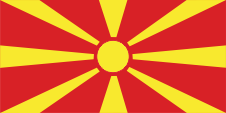
National, state and merchant flag,
ratio = 1:2,
Source, by: Flags of the World







1944,
Independent State of Macedonia,
ratio = 2:3,
Source, by: Flags of the World



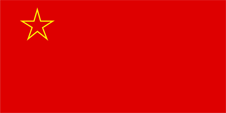
1946–1992,
Flag of Macedonia within the SFR Yugoslavia,
ratio = 1:2,
Source, by: World Statesmen





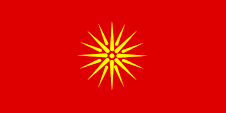
1992–1995,
National, state and merchant flag
ratio = 2:3
Source, by: Flags of the World






The today's flag was officially introduced on 6th of October in 1995. It shows a stylized yellow sun on red ground and its beams reach the border of the flag. The flag remembers the preceding flag (1992–1995) with the "Star of Vergina". Vergina was the capital of the antique Macedonia, which coexisted in emnity with Greece. The colours of the flag seem to be defined today as follows, in hexadecimal: red = #D82126, which would correspond to Pantone 1795 and gold = #F8E92E, which would correspond to Pantone 107. Because of this flag there arised quarrels with Greece, seeing that Greece claims the "Star of Vergina" for itself, just as Macedonia. By the adoption of the today's flag this quarrel was terminated. Macedonia officially never had in its pre-yugoslav history an own flag, If you refrain from the short-lived Independent State of Macedonia, however the Macedonians should have fought in the past under red flags against the Turks.
Source:
Flags of the World,
Flaggen und Coat of arms of the Welt,
Wikipedia (D)

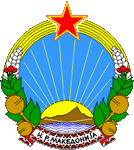
1944–1946,
Coat of arms of Macedonia,
Source:
MacedonianBoy [GFDL or CC BY-SA 4.0], from Wikimedia Commons
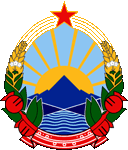
1946–1991,
Coat of arms of Macedonia,
Source:
Đorđe Andrejević-Kun & Antun August Augustinčić (supposed to be the original design authors), Cameltrader (original sVG file), CC BY-SA 2.5, via Wikimedia Commons
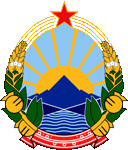
1991–2009,
Coat of arms of Macedonia,
Source:
Đorđe Andrejević-Kun & Antun August Augustinčić (supposed to be the original design authors), Cameltrader (original sVG file), CC BY-SA 2.5, via Wikimedia Commons
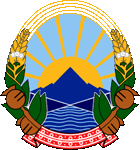
since 2009,
Coat of arms of Macedonia,
Source:
MacedonianBoy [GFDL or CC BY-SA 4.0], via Wikimedia Commons

The historic coat of arms of Macedonia descents from the Middle Ages and shows a red shield with a golden lion. The today's coat of arms was introduced on the 27th of July in 1946 for the socialistic Macedonia as partial republic of Yugoslavia. It shows mountains behind them arises the sun and in the foreground a river. All this is surrounded by a garland of wheat ears, poppy petioles and tobacco leafs. On the underneath border a red banner with a folkloristic depiction. That's because the coat of arms is ostensibly so popular with the people it was maintained after the independence from Yugoslavia. But probably they did not return to the historic coat of arms, because it is so similar to the coat of arms of Montenegro. On 16th of November in 2009 the red star of communism became removed from the coat of arms.
Source:
Flaggen und Coat of arms of the Welt,
Wikipedia (D)

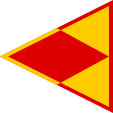
Aircraft Roundel,
Source, by: Wikipedia (EN)

Location:
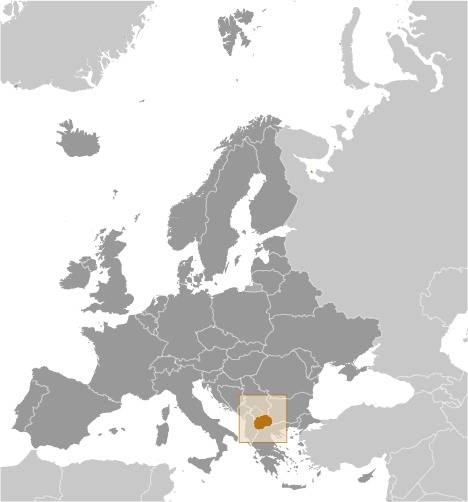
Source: CIA World Factbook
Map of the country:
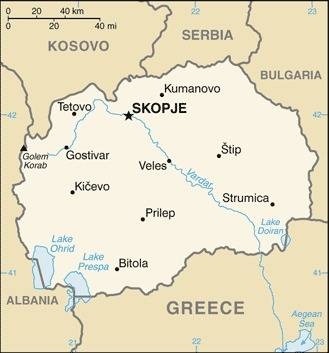
Source: CIA World Factbook
The Position of North Macedonia on the Balkan:
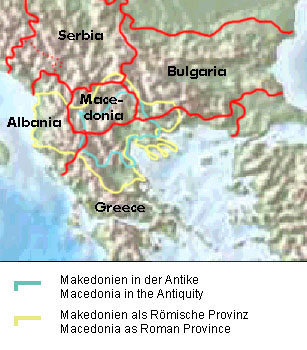
Source: Freeware, University of Texas Libraries,
modyfied by: Volker Preuß
The countries of the former Yugoslavia:
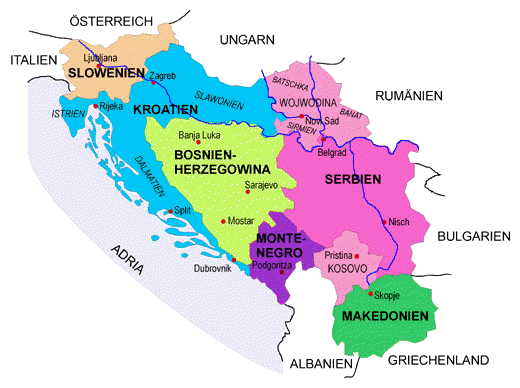
Map: Volker Preuß

Area: 9.928 square miles
Inhabitants: 1.800.000 (2021), thereof 58% Macedonians, 24% Albanians, 4% Turks, 2,5% Gipsies, 1,3% Serbs
Religions: 64% Orthodox Christians, 33% Muslim
Density of Population: 181 inh./sq.mi.
Capital: Skopje, (Serbo-Croatian: Skoplje, Turkish: Ueskueb), 544.086 inh. (2015)
official Languagen: Macedonian, Albanian
other Languages: Turkish, Serbian
Currency: 1 Macedonian Denar (MKD, Den.) = 100 Deni
Time Zone: GMT + 1 h
Source:
Wikipedia (DE)

1200 B.C. · the Greek tribe of the Macedones immigrates in the by Illyrians, Thrakians and Phrygians populated country
700 B.C. · the Macedonian dynasty of the Argeades rules over the country
359–336 B.C. · reign of Philipp II.
336–323 B.C. · reign of Alexander III. (Alexander the Great), son of Philipp II., Macedonia becomes an empire
13th of June 323 B.C. · death of Alexander the Great in Babylon, Macedonia disintegrates
221–179 B.C. · reign of Philipp V.
215–205 B.C. · First Roman-Macedonian War
200–197 B.C. · Second Roman-Macedonian War
171–168 B.C. · Third Roman-Macedonian War, Macedonia loses its independence and becomes partitioned into four states
148 B.C. · Macedonia becomes Roman province
395 A.D. · at the partition of the Roman Empire Macedonia comes to the East Roman Empire (Byzantium)
6th cent. · Slavic immigration and land's grabbing
969–1018 · Macedonia belongs to the West Bulgarian Empire
1018 · Macedonia comes again to the East Roman Empire (Byzantium)
1203 · Macedonia comes to the Bulgarian Empire
1389 · the Turks conquer Macedonia and incorporate it in their Ottoman Empire
1913 · First Balkan War, Macedonia becomes partitioned between Greece, Serbia and Bulgaria
1914 · Second Balkan War, Bulgaria has to cede parts of its Macedonian territories to Serbia and Greece
1914–1918 · First World War: Bulgaria compensates by an invasion in Serbia and Greece in 1915 its in 1914 suffered territorial losses, positional war, an in October 1918 startet invasion of troops of the Entente pushes the Bulgarian troops back and advances within one month through whole Serbia to Belgrad, Serbia forces the unification of the South Slawic nations under its crown in the state "Kingdom of the Serbs, Croats and Slovenes", which was renamed in 1929 in Yugoslavia, Macedonia becomes part of the Province of Vardar
1941 · Yugoslavia gets dissolved during the Second World War, large parts of Vardar are occupied by Bulgarian troops
1941–1946 · Yugoslavia is during the Second World War location of a merciless partisan and civil war between communists (under J.B.Tito), republicans, monarchists and nationalists, the communists prevailed
2nd of August in 1944 · proclamation of the Socialist Republic of Montenegro (within communist Yugoslavia)
1945 · determination and acceptance of a standardized Macedonian language as country's language
29th of November in 1945 · proclamation of the "Federative People's Republic of Yugoslavia" (Macedonia included) by Tito
31st of January in 1946 · proclamation of the People's Republic of Macedonia (within Yugoslavia)
12th of April in 1963 · proclamation of the Socialist Republic of Macedonia (within Yugoslavia)
25th of January in 1991 · Macedonia declares its sovereignty
7th of June in 1991 · proclamation of the Republic of Macedonia
1991–1992 · Yugoslavia dissolves into its particular states (on the 9th of September in 1991 referendum in Macedonia for sovereignty, in November 1991 the today's Macedonia gets a new constitution and is in this way independent from Yugoslavia)
1992 · Greece not recognizes the Republic of Macedonia because of its name and imposes a trade embargo
1993 · adoption of Macedonia as "Former Yugoslav Republic of Macedonia" in the UNO
1995 · Greece recognizes the sovereignty of Macedonia, but Macedonia has to change its flag
1996 · Yugoslavia recognizes the independence of Macedonia
2001 · Albanian separatists try to destabilize Macedonia by terroristic campaigns and open armed struggle
12th of June in 2018 · parliamentary resolution on the future renaming of the country in Republic of North Macedonia
12th of February in 2019 · renamed in Republic of North Macedonia
Source:
Atlas zur Geschichte,
Wikipedia (D),
Discovery '97

The Name Macedonia has its roots in the in ca. 1200 B.C. into the country immigrating – from the northern Thessalia coming – Greek tribe of the Makedones.
Source: Volker Preuß


![]()


















![]()
